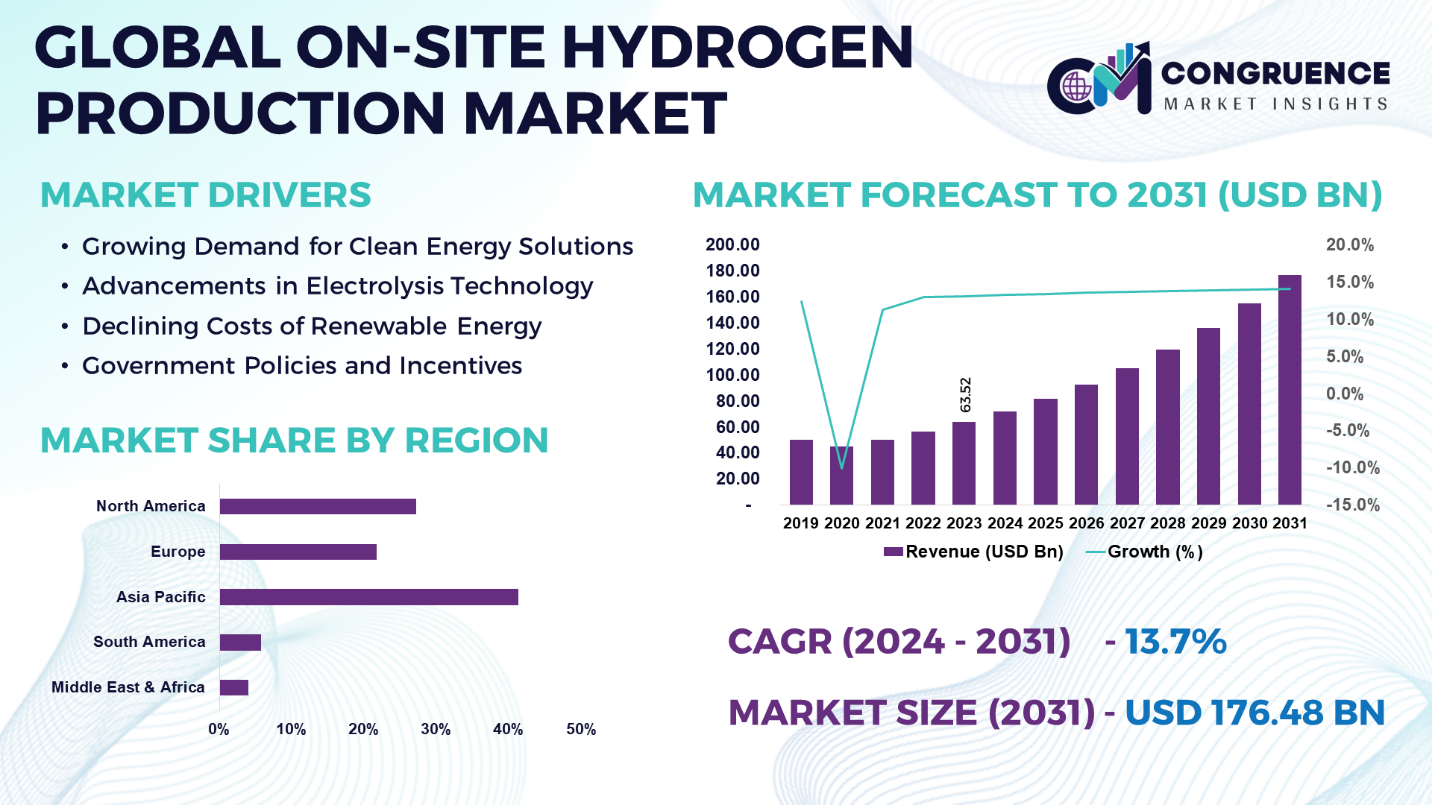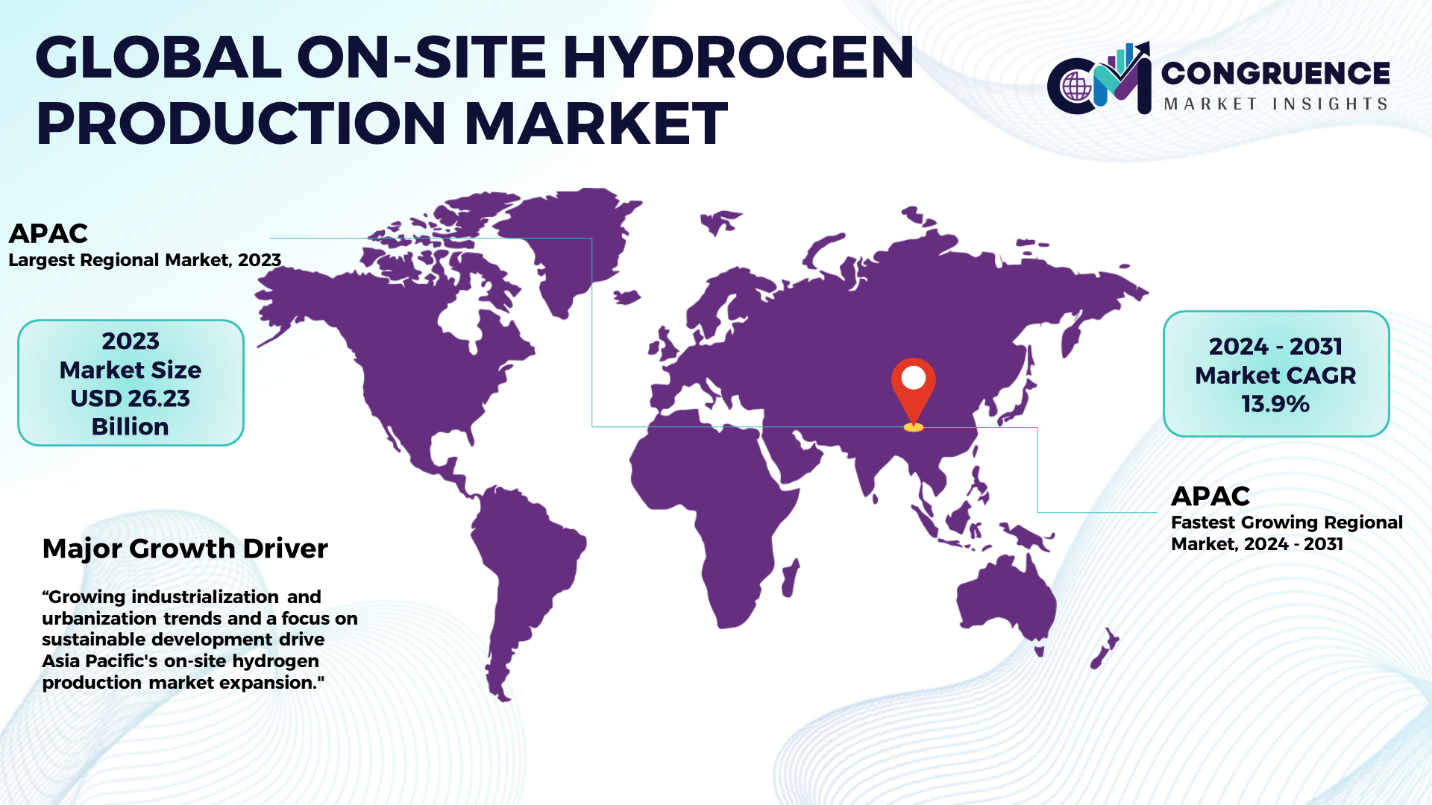Reports
The Global On-Site Hydrogen Production Market was valued at USD 63.52 Billion in 2023 and is anticipated to reach a value of USD 176.48 Billion by 2031 expanding at a CAGR of 13.7% between 2024 and 2031.
The methods to produce hydrogen on-site are still under development, though the product is poised to quickly and dramatically switch a massive market to clean energy solutions. It implies hydrogen production at the point of utilization, and this may include methods such as electrolysis and natural gas reforming, among others. This strategy assists in dealing with the challenges that exist in the transportation and storage of equipment in order to enhance the accessibility and effectiveness of hydrogen delivery. On-site hydrogen production is also quickly becoming popular because the created hydrogen fuel can be used for different operations like transportation, hydrogen vehicles, energy for industries and power plants, etc. Apart from carbon capture and storage technologies, reducing carbon emissions, and combating the impact of changes in the climate, hydrogen is investigating itself as a suitable solution for a clean, efficient, and effective energy storage medium. That is why the production of hydrogen on site can be ranked as the most effective for industries and areas that need high levels of hydrogen and have no fundamental possibility of capacity creation at all or have a rather weak improvement. Another important factor that has contributed to on-site hydrogen production almost doubling in recent years is the advancement in efficiency of technology in use, such as the type of electrolysis to use, and the rapid decline in the cost of renewable energy sources.

On-Site Hydrogen Production Market Major Driving Forces
Growing Demand for Clean Energy Solutions: Hydrogen is a Source of Zero-Emission Fuel that Is Used in Many Fields, and the Growing Concerns with Releasing CO2 into the Atmosphere, as well as Expanding Demand for Clean Forms of Energy, Are Stimulating the Process.
Advancements in Electrolysis Technology: The costs of electrolysis technology are reducing through innovations; hence, widespread use and production of hydrogen at places such as factories are becoming more feasible.
Declining Costs of Renewable Energy: The cost at which renewable energy sources such as solar and wind power are becoming cheaper and thus democratic, thus making it cheaper to produce hydrogen locally, especially via electrolysis.
Government Policies and Incentives: The installation of on-site hydrogen production is being greatly supported by policies, subsidies, and incentives by the governments targeting the promotion of CLENER and the reduction of GHG emissions.
On-Site Hydrogen Production Market Key Opportunities
Expansion in Emerging Economies: The growth and development of industries and cities in the emerging economy offer viable prospects for sustainable on-site hydrogen production due to the increasing interest in clean energy in these economies with increased pollution and factors affecting climate change.
Integration with Renewable Energy Projects: A great potential for growth is observed in the integration between on-site hydrogen production technologies and renewable energy activities. Wind and solar power plants can manage the surplus energy generated by them, which can be utilized to produce hydrogen to ensure stable energy storage.
Development of Green Hydrogen Technologies: It is an indication that markets for entities in the green hydrogen value chain are emerging, specifically using renewable electricity. Opportunities exist because green hydrogen has the potential to stall or push forward the massive industrial transition that is needed to meet the target of limiting global warming to 1.5°C.
On-Site Hydrogen Production Market Key Trends
· Increasing adoption of green hydrogen technologies.
· Rising integration of hydrogen production with renewable energy sources.
· Growing deployment of hydrogen fuel cell vehicles.
· Technological advancements in electrolysis and storage solutions.
· Expansion of hydrogen refueling infrastructure.
· Government initiatives and funding for hydrogen projects.
· Industrial sectors’ shift towards decarbonization.
· Emergence of modular and scalable hydrogen production systems.
· Strategic partnerships and collaborations within the industry.
· Development of decentralized energy systems.
· Advancements in hydrogen blending with natural gas.
· Corporate focus on sustainability and carbon reduction goals.
Region-wise Market Insights
North America accounted for the largest market share at 33.3% in 2023 whereas, Asia Pacific is expected to register the fastest growth, expanding at a CAGR of 4.1% between 2024 and 2031.

North America, with a primary focus on the US and Canada, is seen as the leading region for the on-site hydrogen production market due to its well-established support from the government, fast-paced technological advancement, and preferential shift towards cleaner energy production. Regional experts estimated expenditure towards renewable energy generation would ensure the regions act as key centers for on-site hydrogen production through renewable sources and the large expenditure made towards the development of hydrogen infrastructure. Some of the successful countries that have taken the lead in promoting hydrogen as an energy carrier include Germany, the United Kingdom, Norway, and some other countries in Europe. Hydrogen produced near the point of use has great potential, especially since the EU has set a very ambitious hydrogen strategy and many EU countries have embedded clear policies and funding for hydrogen in their energy systems. Moreover, the region possessing the largest and latest electrolysis expertise, along with the largest renewable power facilities, accelerates market growth. Asia-Pacific is set to strengthen as one of the most relevant regions in the context of on-site hydrogen production due to growing industrialization and urbanization trends and a focus on sustainable development. Industrialized nations such as Japan, South Korea, and China are expanding their investment in the infrastructure for hydrogen and fuel cell systems immensely for the development of their low-carbon economies. In addition, there is ample potential for renewable energy sources in the region, more specifically in the solar PV and wind energy sectors, that can be utilized in on-site hydrogen production.
Market Competition Landscape
The prominent players and innovative startups are intensely trying to capture shares of the on-site hydrogen production market with differentiated and integrated innovations. Market leaders such as Air Liquide, Linde plc, and Hydrogenics Corporation boast a rich experience and a diverse range of products across the globe. These industries require reliable, efficient, and scalable sources of cheap hydrogen production that they integrate on-site, and most spend significantly on R&D. Industry leaders such as Shell, Air Products, and Schneider Electric have come up with innovative PEM and sophisticated large-scale electrolysis systems, while startups, system integrators, and other small-scale players like Nel ASA and ITM Power are also actively offering various electrolysis technologies and modular kinds of designs to customer-specific and various emerging types of markets. Partnerships, M&As, and joint ventures can be the key pathways that enable firms to increase their market share, access to new technologies, and on-site hydrogen production capabilities due to the ongoing changes in the industry setting. Prominent players in the market include:
· Air Liquide
· Linde plc
· Hydrogenics Corporation
· Nel ASA
· ITM Power
· Siemens Energy
· McPhy Energy
· Plug Power Inc.
· Ballard Power Systems Inc.
· Heliocentris Energy Solutions AG
· Green Hydrogen Systems
· Enapter AG
· Adroit Energy Inc.
· Giner Inc.
· Proton OnSite
|
Report Attribute/Metric |
Details |
|
Market Revenue in 2023 |
USD 63.52 Billion |
|
Market Revenue in 2031 |
USD 176.48 Billion |
|
CAGR (2024 – 2031) |
13.7% |
|
Base Year |
2023 |
|
Forecast Period |
2024 – 2031 |
|
Historical Data |
2019 to 2023 |
|
Forecast Unit |
Value (US$ Mn) |
|
Key Report Deliverable |
Revenue Forecast, Growth Trends, Market Dynamics, Segmental Overview, Regional and Country-wise Analysis, Competition Landscape |
|
Segments Covered |
· By Technology (Electrolysis, Steam Methane Reforming, Others) · By Capacity (Small-scale, Medium-scale, Large-scale) · By End-Use Industry (Transportation, Power Generation, Chemicals, Petroleum Refining, Others) · By Application (Fuel Cells, Refinery Hydrogen, Ammonia Production, Methanol Production, Others) |
|
Geographies Covered |
North America: U.S., Canada and Mexico Europe: Germany, France, U.K., Italy, Spain, and Rest of Europe Asia Pacific: China, India, Japan, South Korea, Southeast Asia, and Rest of Asia Pacific South America: Brazil, Argentina, and Rest of Latin America Middle East & Africa: GCC Countries, South Africa, and Rest of Middle East & Africa |
|
Key Players Analyzed |
Air Liquide, Linde plc, Hydrogenics Corporation, Nel ASA, ITM Power, Siemens Energy, McPhy Energy, Plug Power Inc., Ballard Power Systems Inc., Heliocentris Energy Solutions AG, Green Hydrogen Systems, Enapter AG, Adroit Energy Inc., Giner Inc., Proton OnSite |
|
Customization & Pricing |
Available on Request (10% Customization is Free) |
